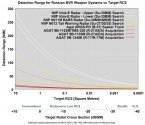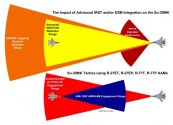Geometry is the most important element of RCS and "true" RCS does not play a role.
Look at this graph and pay attention to the performance of high power and large aperture Irbis-E radar and the low-power and small aperture missile seekers. The first is doing all the combat management, the latter only affects whether the missile hits.
The scale is logarithmic so it distorts data heavily in the upper bounds but the seekers are represented fairly naturally. It doesn't matter that much. Either the IR seeker or constant uplinks (hence the role of ECCM) will address the issue.
View attachment 74755
The greatest reduction in detection range occurs between RCS=10m2 and RCS=0.5m2 all of which can be achieved through geometry alone. Below 0.5m2 we enter into an area where IRST outperforms radar in most atmospheric conditions, but most importantly it is the standard range of modern medium-range air-to-air missile which makes it the contemporary equivalent of missile dogfights of the recent past.
View attachment 74756
Whether your stealth plane has RCS of 0.01 or 0.001 is irrelevant for all purposes other than conservation and maintenance. If you have 0.001 then any loss resulting from use will not increase it beyond 0.1 range determined largely by geometry and selective applications of other techniques in crucial spots on the airframe.
The geometry and RAM matter in terms of reducing scatter from other angles - most importantly high altitude radar. RAM will most likely also try to reduce other wavelenghts because with bombers not being targeted is not as important as not being discovered.
Anyway, just my three cents.


